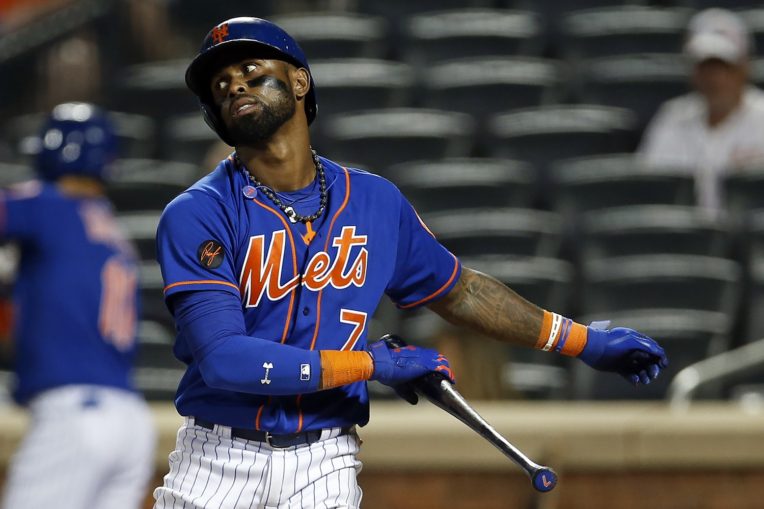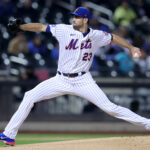
Just about everything has been frustrating this season for the New York Mets. If someone was forced to make a list of the most frustrating things fans have had to endure in 2018, though, Jose Reyes still being on the roster has to be near the top.
After becoming a free agent this past winter, it seemed rather obvious New York would re-sign the veteran infielder. It made perfect sense — they’re both familiar with one another, he has shown the ability to play multiple positions around the diamond, and he apparently has a very good relationship with Amed Rosario.
Although he finished 2017 with just a 94 wRC+, a hot second half allowed him to slug a total of 15 home runs while swiping 24 bases. Reyes still appeared to be a useful on-field asset for the organization, but if 2018 has told us anything, it’s that going from being an every-day player to being a bench player is a difficult transition.
That’s evidenced by Reyes’ .187/.258/.283 triple slash, which includes just three homers, 10 RBI, and five stolen bases in 182 plate appearances. Everyone is aware of how bad he’s played — after all, there’s been discussion about whether he should be on the roster or not virtually season.
Here we are at the beginning of August, though, with the Mets well out of the race with a 45-64 record and Reyes playing more often than he should (he’s started seven games since July 21st). While that’s ridiculous in its own right, how exactly did he get here, and where does this futility rank among other offensive performances this century in team history?
Basically Everything Is in a Steep Decline
Reyes is far from the offensive player he used to be, which is normal for a 35-year-old player that depends on his speed. Still, his second tour with the Mets — especially when looking at his first full campaign in 2016 — had shown some bright spots prior to this season.
He’s never been the kind of hitter to pile up a bunch of hard contact, but the 29.0% hard-hit rate Reyes produced in 2016 was actually a career-high mark. That number has decreased each of the past two seasons, though, as it was 26.7% in 2017 and is currently 23.5%. That also doesn’t look great when it’s paired with a 28.7% soft-hit rate.
What’s interesting is that Reyes’ chase rate is on track to improve for the fourth consecutive season (34.7%, 32.8%, 30.6%, 28.1%). However, it’s hard to reap the benefits of this positive trend with the aforementioned quality of contact or his batted-ball profile.
Reyes has produced a 356 wRC+ and 42.3% hard-hit rate on line drives so far this year, which is right in line with his career norms (366 wRC+, 43.6% hard-hit rate). Unfortunately, his performance on both ground balls and fly balls completely negates any of the warm and fuzzies these numbers could’ve created.
One could say it’s unsustainable to post a -43 wRC+ on ground balls and -8 on fly balls. That very well may be true, but it’s not at all surprising upon seeing his hard-hit rate for each of these two batted-ball events decrease each of the last three years, while also sporting a soft-hit rate above 30.0%.
Racing for the Basement
Posting a 51 wRC+ and -1.0 fWAR by the time August rolls around is never a good thing, and that’s reflected when compared to the rest of baseball. Among players with at least 170 plate appearances in 2018, Reyes is one of the 10 worst with regard to wRC+ and five worst with regard to fWAR.
Believe it or not, he should be fortunate those numbers aren’t lower — entering August (and before his two-homer game on August 1st), he owned a 39 wRC+. So, yea, it actually could be worse, even though that doesn’t feel possible.
Things don’t get better for Reyes when looking at the worst singular offensive performances within the organization this century, either. Among Mets players who have accumulated 200 plate appearances in a single year since 2001, Reyes’ 51 wRC+ would slide in as the fourth worst.
The only players currently worse? Jason Bay (shudder) in 2012 (50 wRC+), Ruben Tejada in 2013 (48 wRC+), and Joe McEwing in 2002 (42).
Woof.
Adding Insult to Injury
Reyes has been bad this year. This isn’t groundbreaking news of any kind for people who have been paying even the slightest of attention to 2018’s disappointing results. Considering the club’s current position and apparent belief they can contend next year, the rest of the current regular season is crucial prior to forming and executing a strategy for the winter.
That’s why Reyes playing as much as he is — and the signing of outfielder Austin Jackson — makes no sense. Using historical context to show exactly how bad Reyes has been should make that crystal clear, too (as if it wasn’t already).
New York needs to really see what they have in guys like Jeff McNeil (who’s starting to heat up), Dominic Smith, and Peter Alonso prior to September in order to have a more concrete grasp of exactly what the roster needs moving forward. Reyes, Jackson, and Jose Bautista shouldn’t be part of the future (even though it’s being reported Bautista could be), and it’s ridiculous that these three are commanding as much playing time as they’ve been getting.
Every contending team needs a handful of useful veterans around, but the Mets are far from contention, and everyone already has an idea of what these guys have left in the tank. Reyes’ situation is probably the most clear of all — it’d be stunning if he’s back in Queens next year, and he has next-to-no value as the waiver trade deadline approaches. So why is he even still around soaking up playing time someone else could use?
That’s a really good question nobody within the organization has yet to provide a solid answer to this season.















